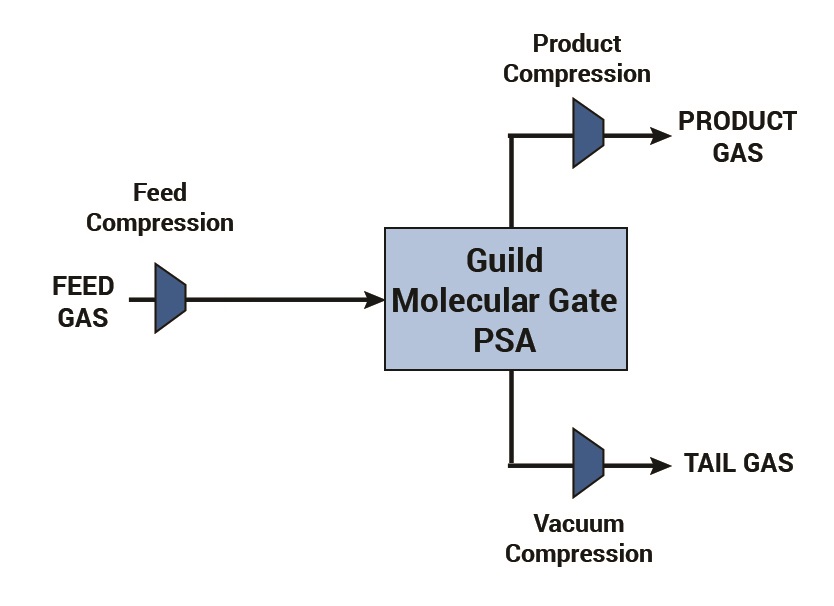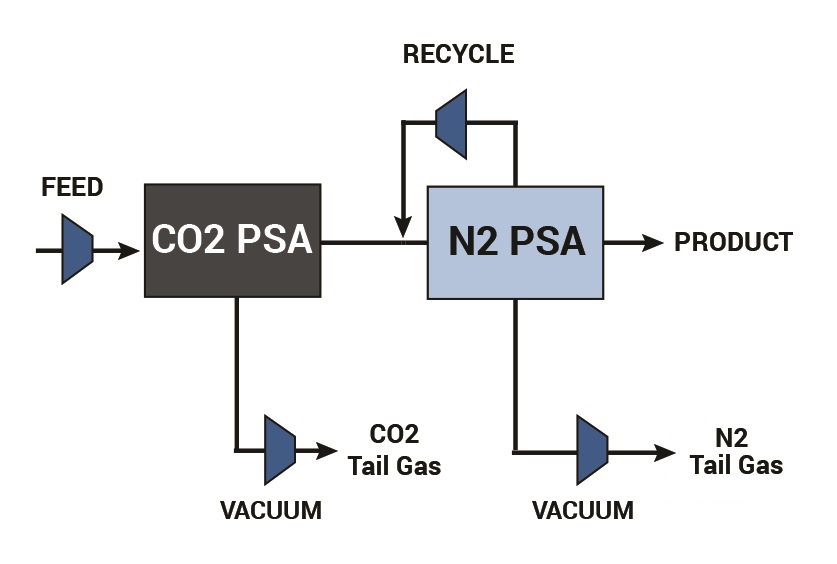LNG PRETREATMENT FOR LIQUIFIERS
The Molecular GateTM adsorption process uses Pressure Swing Adsorption (PSA) to remove carbon dioxide (CO2) from natural gas to 50 ppm or less and bulk removal of nitrogen using specially developed adsorbents with high selectivity between methane and these impurities. This technology has been successfully implemented in two long running LNG systems (one in the United States and the other in the United Kingdom), both using landfill gas as the source gas. Since the Molecular GateTM process can remove water, carbon dioxide and heavy hydrocarbons single step process, this greatly simplifies the operational site over the conventional approach of using combinations of amine systems, membrane systems, and Temperature Swing Adsorption (TSA) adsorption systems.

Because carbon dioxide freezes in a liquefier at levels above 50 ppm, the pipeline gas fed to a liquification unit requires pretreatment for the removal of the residual carbon dioxide in the pipeline gas. Further, the pipeline gas is typically dehydrated to levels of seven pounds per MM SCF (approximately 150 ppmv) and since water will also freeze in a liquefier, the water level must be reduced to 1 ppm or less. Excess heavy hydrocarbons can form solids in the liquefier and their presence may need to be addressed in the design of the liquefier. A Guild Associates Molecular Gate LNG pre-treatment can remove all of these impurities in a single-step process, or a simple two-stage process depending on the feed gas specification.
In the Molecular GateTM system shown at the left, CO2 and water are adsorbed at high pressure while the purified natural gas passes through the adsorbent bed at near feed pressure. The adsorbed CO2 and water is subsequently removed at low pressure and leave the system along with any unrecovered hydrocarbons for use as fuel.
The Molecular Gate system also co-removes any larger hydrocarbons (C4+) in the feed, which can be desirable for liquefier operation. Adsorption systems for LNG pretreatment are appropriate for a wide range of flows from 0.5 MMSCFD to 20 MMSCFD, or more. System turndown is to zero flow and systems are noted for ease of operation, environmental friendliness with high reliability.

Where the targeted feed gas for the LNG plant contains high levels of nitrogen the Molecular Gate system can be used to remove both CO
2 and nitrogen in a single step. The typical system configuration is shown in the figure to the left. The Molecular Gate technology is noted for its ability to remove nitrogen to pipeline specifications (typically 3-5%) and LNG pretreatment using Molecular Gate for LNG would remove nitrogen to similar levels while also removing the CO
2 to less than 50 PPM.
Guild Associates provides adsorption-based systems for dehydration, hydrocarbon dew point control, CARB specifications, N2 rejection and CO2 removal. Systems provided include both Thermally Swing Adsorption (TSA) systems and PSA's.
For higher levels of CO2 or for the need to improve the methane recovery to the LNG plant a two stage design can be incorporated. The first stage can be PSA or other bulk CO2 removal technology such as membranes.